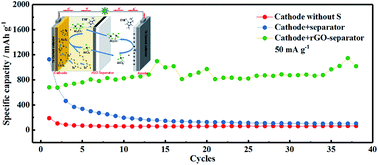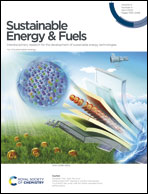Design of a composite cathode and a graphene coated separator for a stable room-temperature aluminum–sulfur battery†
Abstract
Both aluminum and sulfur are promising materials for future-generation electrochemical energy storage technology owing to their natural abundance, low cost, and high capacity. However, a rechargeable aluminum–sulfur (Al–S) battery with high energy density suffers from poor reversibility and very short cycle life. Herein, a graphene/CoS2/sulfur composite cathode together with a reduced graphene oxide (rGO) coated separator are fabricated to improve the room-temperature Al–S battery performance. The rGO coating on the separator along with the composite cathode form a sandwich structure which effectively suppresses the diffusion of polysulfides and decreases the polarization of the battery. As a result, the Al–S battery gives a stable cycle life of 38 cycles with a high discharge capacity range of 676–1145 mA h g−1 at 50 mA g−1; the performance is greatly improved compared with the bare separator. Electrochemical, spectroscopic, and microscopic analyses illustrate the mechanism of electrochemical reactions in detail. These meaningful studies facilitate a remarkable step forward in the progress of Al–S batteries.

- This article is part of the themed collection: Sustainable Energy & Fuels Cover Art


 Please wait while we load your content...
Please wait while we load your content...